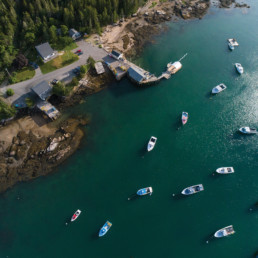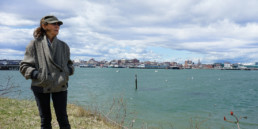The Long Journey from Boat to Plate
A complex supply chain, heavy on infrastructure, delivers lobster
Story by Laurie Shreiber
Photos by Jack Sullivan
It’s 2:30 in the morning and the wharf staff at Fifield Lobster Company in Stonington is preparing for the arrival of about 40 commercial fishing boats in the next few hours, with the vessels landing just long enough to load up on bait and fuel.
The captains and their crews will then head out for a day of hauling. Most work closer to shore and return with loads of lobster between noon and 4 p.m. The larger boats return from farther offshore in the evening.
The comings and goings might seem hectic but are well-organized.
“The bulk of our fishermen usually start setting their traps in May,” said the company’s co-owner, Travis Fifield. “The inshore guys run through the end of December. We have seven or eight offshore boats. They’ll go all winter.”
But what happens to all those lobsters coming to the wharf, day in and day out? At Fifield’s wharf, that amounts to over a million pounds per season. Throughout the state, it was 96.6 million pounds in 2020. That’s a lot of creatures hauled live from their homey ocean bottom to an alien terrestrial setting in a fishery whose most important mission is remarkable given the global distances many travel: keep them alive and healthy.
“There’s a lot of work that goes into that,” said Annie Tselikis, executive director of the Maine Lobster Dealers’ Association in South Portland. “It’s not just a matter of moving lobster quickly. It’s also about doing right by the lobsters themselves. They are sensitive animals.”
To accomplish the job, it’s important to remember that Maine’s lobster fishery isn’t just the fishermen. It’s a wide-ranging network of buyers, distributors, and processors that supply a diverse market—grocery stores, restaurants, hotels, cruise ships, direct-to-consumer—spanning everything from tiny tourist enclaves to major metropolitan regions around the world.
Lobster journeys begin when they’re plucked from traps, placed in holding tanks on boats, and taken to buying stations. The station could belong to a private company or a lobster cooperative. Or it might be a public landing, where buyers stand ready with refrigerated trucks.
After tying up, fishermen unload the undifferentiated lobsters into standardized plastic crates.
“That’s the first point of receiving them at the wharf or the co-op or the buying station,” said Tselikis, noting the terms are generally interchangeable. “At that stage, fishermen get paid and are done with the product.”
The crates go onto refrigerated trucks for transport either to live-lobster distributors or to processors.
Those going into the live system are graded for shell quality and size.
“If I’m going to ship lobster to South Korea, I’m looking for high-quality, lively, hard-shell lobsters, because that lobster will be the most likely to survive a 30-hour journey from Portland to Seoul,” she said.
Some markets request certain sizes. For example, Spain prefers smaller animals; Asia prefers larger. The industry must be ready any time of year. For that reason, Maine is closely connected to eastern Canada, whose winter fishing season kicks in just when Maine’s is winding down, providing dealers with a plentiful source when demand is still high, particularly for holidays such as Christmas and Chinese New Year.
Lobsters depart Maine loaded onto pallets by the thousands of pounds and delivered by truck or plane.
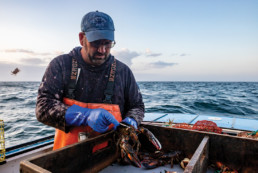
A lobsterman measures his catch to ensure it’s legal for market. Lobsters must have a carapace 3.25-5 inches and not be an egg bearing female in order to be sold at the dock.
If you’re flying to a place like Hong Kong or Dubai, not only is your luggage in the belly of the plane, but so are Maine lobsters,” said Tselikis.
The strategy is a bit different for lobsters going into the value-added processing stream.
“It’s a volume game,” said Tselikis. “We’re looking for very good quality lobster with high meat yields to meet the demands of processing plants.”
Working with one of the most expensive proteins on the planet, the industry is constantly investing in more efficient ways to deliver product, whether it’s a specific live lobster grade or picked meat or frozen tails.
“For example, cruise ships buy frozen tails, not live lobster,” she said. “Tails are easy to put on a buffet. But food trucks and quick-service restaurants look for lobster meat for their lobster tacos or lobster pasta. Live lobster goes to white tablecloth restaurants or to lobster shacks.”
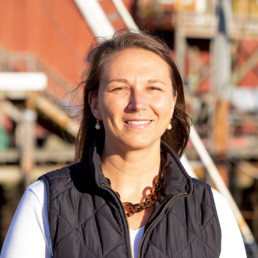
Annie Tselikis, executive director of the Maine Lobster Dealers’ Association
Constant innovation of technologies for functions such as rapid freezing, high-pressure processing, and water-quality sensors for live lobster holding tanks has been essential to the success of processing and distribution. The supply chain is also a major employer. According to a 2017 study conducted by Colby College for the MLDA, about 6,000 people operate the supply chain in a variety of roles—wharf workers, buyers, production, meat-pickers, sales, truck drivers, finance and administration, and quality assurance.
Passersby might never notice these businesses, which are often pretty nondescript on the outside.
“There are facilities in Maine holding 100,000 to 300,000 pounds of live lobster at any given time,” said Tselikis. “There’s much more to this industry than, I think, the general consumer understands, because it’s largely invisible.”
But substantial infrastructure is needed to support the system.
“The most valuable part is waterfront access, which is the part that a lot of people don’t consider to be a service,” said Fifield. “If we didn’t provide it, who would?”
Then there’s infrastructure such as fuel tanks, freezers, forklifts, hydraulic hoists, skiffs, floats, and moorings. All require regular maintenance and repairs. At Fifield’s operation, that can amount to $100,000 per year.
Power and water are also big expenses.
“We require water for lobster processing and for holding facilities,” said Tselikis. “Power is critical because we’re dealing with major refrigeration units for water systems, storage, ice making, and processing infrastructure.”
Other major costs include processing equipment, packaging designed for every specific product and market, trucking, cold storage facility usage, ongoing maintenance costs, and payroll.
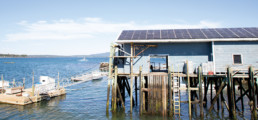
The Cranberry Isles Co-op placed solar panels on all four of its buildings, the largest of which is on the bait shed.
The logistics of running a buying station on an island are a bit trickier. At the Cranberry Isles Fishermen’s Co-op, product is loaded onto two boats owned by the co-op and taken to the mainland, where buyer trucks await, said General Manager Marc Nighman.
“We have a deal with a dock on the mainland to use their wharf to load the trucks, so that’s an added expense to being on an island,” said Nighman.
Pricing throughout the supply chain is determined by supply and demand, with expenses such as labor and storage factored in.
“Every year is different,” Nighman said. “I talk to other co-ops and say, ‘What are you getting from your buyers?’ With all the social media now, if somebody across the pond is getting a dime more than me, I know it and I call my dealer and say, ‘Hey, they’re giving him a dime more.’ They’ll say, ‘It’s probably an isolated thing.’ I say, ‘The thing is, it’s isolated in my backyard.’ If I sell [at a dime less] to you today, I’ll hear it from my fishermen tomorrow—or more likely today because they’ll communicate it over the radio.’ Usually the buyers are pretty good about it.”
Such day-to-day interactions are the unseen part of the industry.
“People have romanticized the fishing industry for generations,” said Tselikis. “But one thing that’s so motivating for me is how the product gets to market and how you build those markets. I’ve been coming up in the industry for the last 15 years. Our volume and global market and demand have increased rapidly. Lobster companies are very good at getting this product to customers around the world.”
Laurie Schreiber has been covering Maine fisheries for 30 years, writing for publications such as Mainebiz, Maine Boats, Homes & Harbors, and The Working Waterfront. She is also the author of Boatbuilding on Mount Desert Island. She lives on MDI.

